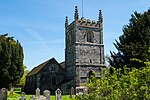Shapwick, Dorset

Shapwick is a village and civil parish in east Dorset, England, situated on the River Stour five miles south-east of Blandford Forum and eight miles north of Poole. The village had a population of 190 in 2001. Within the parish, about a mile to the north-east of the village, is the Iron Age hill fort of Badbury Rings.In Roman times there was a Roman Fort at Crab Farm, between Shapwick and Badbury Rings. Just to the west of the fort was a small Romano-British town, believed to be that listed in the Antonine Itinerary as Vindocladia.Shapwick lay on the important Roman Road from Old Sarum to Durnovaria. The river Stour was forded here. House numbers above 200 in the High Street contrast with the smaller number of houses there at present. As the village declined, burnt down thatched cottages were not replaced. In 1983 Shapwick was used as one of the two real life locations for the Doctor Who story The Awakening. The other village used was Martin in Hampshire. One of its most famous residents was Charles Bennett who won the 1500 metres at the 1900 Summer Olympics.
Excerpt from the Wikipedia article Shapwick, Dorset (License: CC BY-SA 3.0, Authors, Images).Shapwick, Dorset
High Street,
Geographical coordinates (GPS) Address Nearby Places Show on map
Geographical coordinates (GPS)
| Latitude | Longitude |
|---|---|
| N 50.8175 ° | E -2.0879 ° |
Address
High Street 206
DT11 9JT , Shapwick
England, United Kingdom
Open on Google Maps











